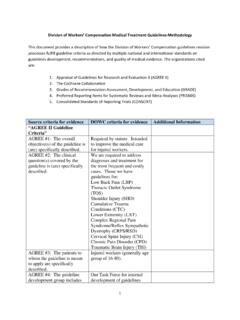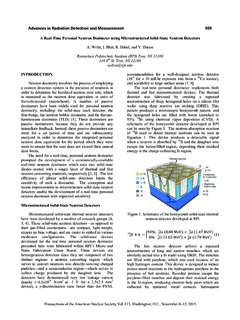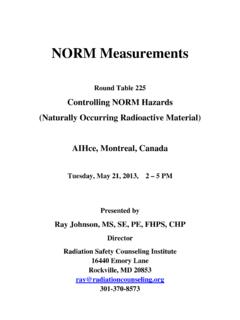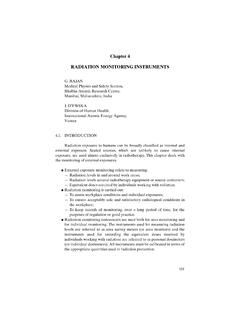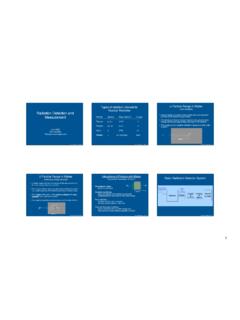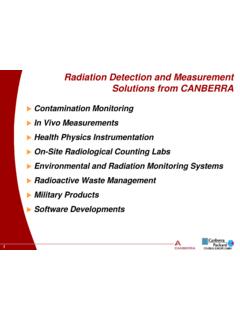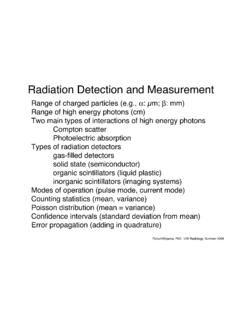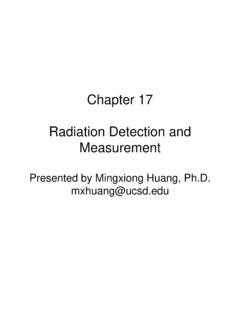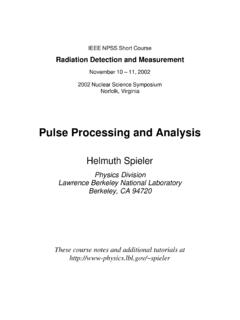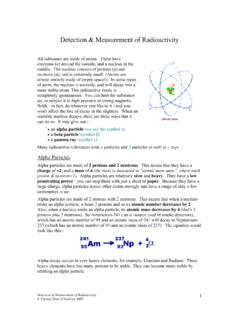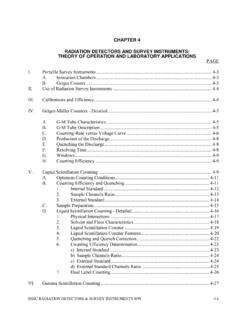Transcription of Radiation Detection Equipment - colorado.gov
1 Radiation Detection Equipment For WIPP Incidents Introduction Determining Radiation Equipment needs is complex. Consideration needs to be given to the following elements: Application: Detection versus measurement of Radiation The rRole, experience and knowledge of the user. at an accident Experience and knowledge of the userOperating environment: tTemperature, moisture, vibration, shock, altitude Information required: cContamination or Radiation measurements Size, weight and portability of instruments Cost and durability of instrument Energy, type and level of Radiation being measured Sensitivity and accuracy required Calibration and repair costs Warranty on instrument For each state these elements may be different and may require different instruments.
2 Differences in state requirements may require A variety of instruments from simple Geiger-Mueller (GM) tube detectors to sophisticated thin-crystal sodium-iodide (NaI) scintillation detectors might be needed in response to a WIPP transportation accident. Fortunately, responders can quickly assess and mitigate most incidents using very basic instrumentation. Most Radiation Detection and measuring devices consist of a detector attached to an electronics package. Sometimes these two pieces are integrated into a single package. Dosimetry Following initial response, personnel working around radioactive materials should/must monitor their exposure.
3 Intital responders may Uuse of dosimeters may also help reassure responders and to provide additional safety. Several methods can be used. Some type of personal dosimetry is usually used to monitor personal this purpose. The simplest variety, self-reading pocket dosimeters, are commonly found in civil defense kits, although the high ranges of some models may not be suitable for emergency response. This type is very rugged and relatively inexpensive. One drawback is that the dosimeter must be read or recharged prior to use. A separate battery-operated charger is usually required to charge the dosimeters although the dosimeter does not require a battery.
4 New FEMA developed and produced a limited quantity of advanced chargers that do not require batteries are available from several vendors. 1 Newer dosimeters have digital readouts, preset alarms and audible outputs. Some models provide the dose rate similar to a ratemeter. Dose and dose rate alarms provide additional awareness of high Radiation levels. An audible output will quickly alert responders of rapidly changing Radiation levels. This type of dosimeter is more expensive than the self-reading types.
5 They are also more fragile and require batteries to operate. Special chargers may also be required. Many different makes, types and models of dosimeters are available and each has its own merits. Price and features should be considered carefully prior to purchase. The lowest cost item may be the best choice to meet your needs. Detector Types Area Radiation and contamination surveys are conducted during the recovery phase to determine the magnitude and extent of the radiological incident. Surveys are also conducted to ensure proper site restoration. This phase requires more accurate and sensitive measurements. Detectors are primarily selected according to the characteristic radiations emitted by the material at the scene.
6 Most transuranic materials primarily emit alpha Radiation . Alpha Radiation is difficult to measure in a field environment because of its short range. Fortunately, other types of Radiation are usually emitted with the alpha. Because gammas can travel great distances they are very useful for obtaining accurate measurements. The most popular instrument for Detection and measurement of radioactive contamination is a pancake-style GM probe attached to a simple ratemeter. It can detect all three types of Radiation at levels close to background. It is relatively inexpensive. Disadvantages include its low gamma efficiency, errors due to varying energy, high count rate losses, and its fragile window.
7 The side-window GM tube is the most common detector used for measuring Radiation levels. It is accurate, inexpensive and moderately sensitive. It cannot detect alpha Radiation , but it can detect some types of beta Radiation . Some of these are designed to minimize errors due to Radiation energy. Radiation surveys may be required to verify boundaries, develop worker stay times, verify shipping container integrity, and help locate lost sources. Radiation surveys of the vehicle and package must also be completed as part of the post-accident vehicle inspection. The detector should respond uniformly to various Radiation energies. Detectors that respond quickly to changing Radiation levels are preferable in the assessment phase.
8 The detector/meter combination should also be able to accurately measure low Radiation levels close to background levels. The side-window GM tube fulfills these requirements. Ratemeters 2 The electronics package or ratemeter is the most expensive component. The ratemeter is offered in a wide variety of models and styles. Generally the more features the higher the cost. The use of modern electronic technology has increased the number of features, often without raising the price. A bare-bones ratemeter usually features an analog meter face, manual range switching, a high voltage power supply and a connection for the probes.
9 Most Radiation Detection and measuring devices consist of a detector attached to an electronics package. Sometimes these two pieces are integrated into a single package. Additional features that may be desirable include: Audible output - Easier to identify changing Radiation levels Digital instead of analog readouts - Easier to read Variable response time - Instrument response can be slowed for more accurate readings Automatic range changes - Easier to use Automatic detector recognition and configuration - Easier to use, less training required Lighted meter face - Night time use Dead time compensation - Extends high range capabilities of GM detectors Integrating or counting capability - More accurate measurements Preset alarm - Provides additional warning of potentially dangerous levels Many different types and models of Radiation instruments are available for evaluating the radiological environment.
10 A variety of types could be used to fulfill the same requirement. Advantages, disadvantages, features and cost must all be evaluated before deciding on an instrument. Other Types of Instruments Other types of instruments may also be useful at a WIPP transportation incident. For instance, sodium-iodide (NaI) scintillation detectors have a higher efficiency for gamma Radiation than the GM probes and therefore they are more sensitiveefficient. Although more sensitive, NaI detectors may not be as accurate as GM probes. NaI detectors are very energy dependent and may over or under respond depending on what energy it was calibrated at. Special thin-crystal low-energy NaI detectors are especially useful for measuring plutonium or uranium contaminations in a field environment.
